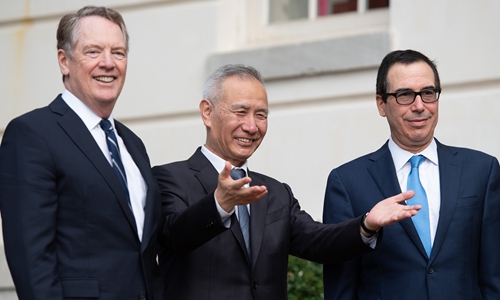HOME >> SOURCE
Signing phase one deal just a new beginning
Source:Global Times Published: 2020/1/9 22:23:40

Chinese Vice Premier Liu He (center), US Treasury Secretary Steven Mnuchin (right) and US Trade Representative Robert Lighthizer pose for a photo as Liu arrives for trade talks at the Office of the US Trade Representative in Washington, DC. Photo: VCG
After much speculation about the signing of the phase one trade deal between China and the US, Beijing announced on Thursday that Vice Premier Liu He will lead a delegation to Washington from January 13-15. That essentially means that the agreement is finally done and it only needs to be signed.While global markets had been expecting the deal, which was reached in mid-December, the announcement, coming at a time when the world economy encounters new uncertainty stemming from rising geopolitical tensions in the Middle East, would no doubt clear away at least some dark cloud hanging over the global economy.
However, it should also be crystal clear to all that the phase one deal is not the end game - far from it, it's just a new beginning for Beijing and Washington, where both challenges and opportunities in the bilateral relationship.
Even as markets cheer the phase one deal, the harsh reality is that both sides have left intact many of the punishing tariffs on each other's products, they still don't see eye-to-eye on many issues and tensions in a wide range of areas are lingering or even escalating. Much work remains to be done. Challenges and risks are also abundant.
First and foremost, the phase one deal should be cherished and properly implemented. Some might be tempted to bad-mouth the deal because it will be signed by senior trade officials rather than the leaders of the two countries as some had speculated. Such petty criticism is meaningless because it will still be a legally binding document if signed by representatives of the two governments, regardless of the signatories' official ranks.
Also, some might want to cherry-pick certain parts of the text of the agreement to judge who won and who lost. Needless to say, such an assessment is pointless. The bottom line is that this is a deal accepted by both sides after months of tough negotiations. Once it's signed, it's a deal that must be treated seriously by both sides.
That brings us to the most important part of this deal - or any deal, for that matter: the implementation. Although the final text of the agreement will only be released after it's signed, officials have confirmed that under the deal, the US would roll back tariffs in phases and China would increase purchases of US products, based on its own market demand.
China will surely stick to its commitment, as there is a massive demand for US products including agricultural goods.
If barriers such as tariffs were to be removed as part of the phase one deal, there is no reason that Chinese companies wouldn't buy more from the US.
Given the tremendous unpredictability in Washington, all eyes will be on US officials to follow through on their promises: scrapping the tariffs in phases.
After all, the trade war started because of the tariffs and should end with their total removal. It cannot be stressed enough that this is not only good for China but also for the US, as well as the world economy.
Despite its perceived limitations, the phase one agreement opens a favorable path for Beijing and Washington that could lead to amicable solutions even during tremendous hostility and seemingly endless tension. All parties should cherish this opportunity, rather than undermine it.
Posted in: GT VOICE